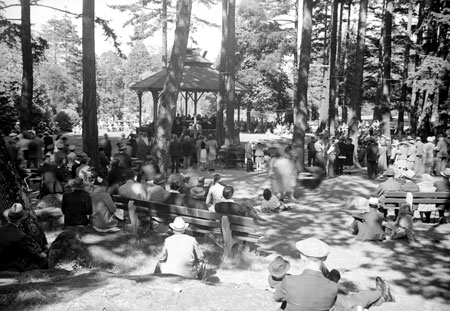Jul
16
Then and Now - Bandstand Two
Jul 2014
 |
| Image # I-00864 courtesy of the Royal BC Museum, BC Archives |
By Ted Ross
Things were prosperous in Victoria in the 1920s. Beacon Hill Park was a busy place on sunny summer days. Crowds of watchers took in the performances at the old bandstand by the Stone Bridge. It had been there since 1888, one of the park's first improvements. That venue was somewhat cramped for spectators by the closeness of Goodacre Lake and the bridge. This caught the city's eye. Tenders were called and monies approved for a replacement.
Beacon Hill Park's second bandstand was constructed in 1926. It was painted and ready to use for 1927. The mayor's report, issued on December 30, 1926, stated, "A new Band Stand is now in the course of erection in Beacon Hill Park, a new location having been chosen in a more convenient situation."
It's not clear exactly where that location was, although Janis Ringuette says in her Beacon Hill Park History, "Some park staff say it was located where Arbour Lake is now." She adds that the Parks Superintendent in 1948 said it was about 100 yards south of the Cameron Bandshell.
Whatever its bearings, the new stage was a popular spot. By the early 1930s, however, the stress of the Great Depression was on Victoria. There was no money in anybody's pocket to spend. But the free performances at the bandstand carried on through those summers.
The new bandstand was well used. Parks Superintendent W.H. Warren, in his 1933 report, mentions that, "The Band Concerts started on April 24, much earlier than usual, and did not conclude until September 10."
A city archives image, from 1934, shows a large crowd seated on benches and around tables in the field to one side of the stand. Many more are seated on benches in the trees around the structure.
People would flock to the park on the warm summer days of those hard years, the entire family finding company and fun without spending any money. Food and drink would be packed in from home kitchens. Entertainment was provided on the park bandstand. It was a lot of fun for folks with no funds.
Following the outbreak of World War Two in 1939, economic conditions improved vastly. By 1941 Victoria Machinery Depot was building war-time ships at Shoal Point, on the old Rithet Wharves site. Business was booming in Victoria, thanks to the wartime economy.
But for the sailors at sea in the north Atlantic, these were hard times. German U-boats were sinking allied shipping faster than it could be replaced, with terrible loss of life. By the summer of 1943 things were looking better, as U-boat detection and destruction techniques improved, and workers in James Bay and dozens of other yards built the replacement ships needed. People still, however, required comforting and reassurance that things were improving.
A BC Archives photo entitled, 'A "Cheer Up Concert" in Beacon Hill Park,' shows a good-sized gathering taking in a concert presented by Pop Green in 1943. People are seated on benches or just standing around enjoying the performance. In the sunny field, centre/left in the photo, picnic tables can be seen, with folks sitting to watch the show. The bandstand served to make sad people feel better.
With the war's conclusion in 1945, the stand continued to entertain the people of Victoria on pleasant summer evenings. In his 1946 report, Superintendent Warren says, "A very successful concert season was held in Beacon Hill Park....Altogether it was estimated that 40,000 persons attended free concerts..."
We wonder if Mom and Dad, with the new baby, spread a blanket or sat at one of the tables, and ate a picnic meal while enjoying a performance on the bandstand. Considering the numbers reported, there must have been plenty of folks about the park. It would have been a grand way to pass a summer afternoon.
Warren reports in 1947, "There were 13 concerts in Beacon Hill Park by the Park Band and four by other bands during the period from May 18 to August 31, 1947..." It was another successful season for the second bandstand and the citizens of Victoria. But it was also to be the last year for the stand.
The Report of the Parks Superintendent for 1948 tells of the bandstand's demise. "Following construction of the Cameron Memorial Pavilion the old bandstand erected in 1926 was demolished." So ended the existence of a very popular public place without any fanfare at all, beyond a short report and picture in the Victoria Times.
Cameron Bandshell stood brand-new, ready to take on the task of presenting all those summer entertainments Victorians had become used to. It continues to do so today, sixty-six years later.
We're not quite sure where Bandstand Two was, but we do know and love the Cameron Memorial Bandshell, with its wonderful warm weather programs. It's our stage in-the-park, always gratis!
Bibliography
City of Victoria, "Mayor's Report, 1926," Victoria City Archives; City of Victoria, "Mayor's Report, 1927," Victoria City Archives; City of Victoria, "1933 Report of the Parks Superintendent," Victoria City Archives; City of Victoria, "1946 Report of the Superintendent of Parks," Victoria City Archives; City of Victoria, "1947 Report of the Parks Superintendent," Victoria City Archives; Victoria Times, "Old Bandstand In Park To Go," February 3, 1948, City of Victoria Archives, Clippings File; Archival Photographs, Victoria City Archives; Archival Photographs, BC Archives; Ringuette, Janis, "Beacon Hill Park History, Chapter 10," 2004; shipbuildinghistory.com, "Victoria Machinery Depot (VMD)," Victoria BC, 2010; Wikipedia, "Battle of the Atlantic," 2014.
